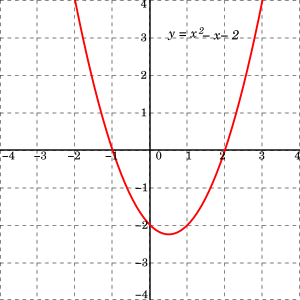A-level Mathematics/CIE/Pure Mathematics 1/Functions
Notation & Terms
Function Notation
There are two main ways of describing a function: with parenthesis notaton, e.g. , or with mapping notation, e.g. . These both describe what the function does.
Definitions
- Function
- A function is a mapping from an input set to an output set. For example, the function maps the input to the output by multiplying it by 3
- Domain
- The domain is the set of all valid inputs. e.g., the function has the domain .
- Range
- The range is the set of all possible outputs. e.g., the function has the range
- One-to-one function
- A one-to-one function is a function which maps each input to exactly one output, and each output corresponds to exactly one input. For instance, is not a one-to-one function, but is a one-to-one function.
- Inverse function
- An inverse function is a function that does the opposite of another function. For example, the function has an inverse function .
- Composition of functions
- Composition of functions is where the output of one function is input into another function. For example: if and , the composed function and the composed function . Note that for two arbitrary functions and , the composed functions and are not equal except for some special cases.
Finding the Range

To find the range of a function, we need to find the highest and lowest values that the function can take.
Example 1
Find the range of
The lowest value that can take is 1, so one bound of the range is .
The highest value that can take is infinite, so the other bound of the range is the value that approaches as goes to infinity, which is 0.
So the range of the function is . This range can also be expressed in interval notation as

Example 2
Find the range of
A quadratic function always has a turning point, known as its vertex. This determines its range. The vertex can be found by completing the square.
Completing the square provides the coordinates of the vertex, .
Since the vertex is the lowest point of this function, we can express the range as , which can be expressed as
Composing Functions
A composite function is a function which is created by taking the output of one function as the input of another function.
e.g. Find the composite function when and .
It is important to note that a composite function can only be created if the range of the inner function is within the domain of the outer function.
Inverse Functions
An inverse function is the reverse of a given function, such as how has the inverse .
However, not all functions have an inverse. Only one-to-one functions have an inverse.
Determining whether a function is one-to-one
The formal way of determining whether a function is one-to-one is to prove that
e.g. Prove that is one-to-one.
Finding the inverse
To find the inverse of a function, substitute for in the function definition then rearrange the variables to make the subject of the formula.
e.g. Find the inverse of
Graphing Inverse Functions

If you plot a function and its inverse on the same graph, it is apparent that the graph of the inverse is the same as the graph of the function reflected across the line .
The reason for this is that the graph is equivalent to
Transforming Functions
A transformation of a function changes the position, size, or shape of the function's graph.
- Translation
- Translation changes the position of the function's graph. can move the function vertically and can move the function horizontally.
- Scaling
- Scaling is where the function changes in size. changes the size vertically and changes the size horizontally. If is negative, the function will also be reflected.
- Reflection
- Reflection is where the function is mirrored across a given line. This can be achieved with for vertical reflection and for horizontal reflection.